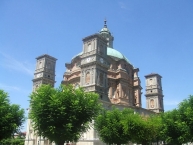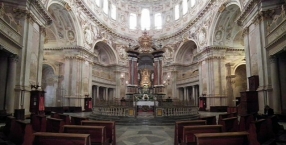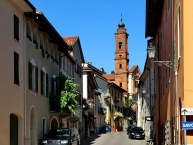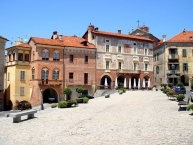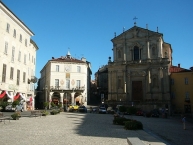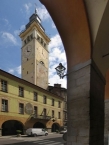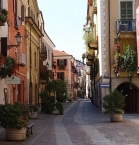Pedemontana Alpina Radweg
Nr. des Radweges BI12
Aktionen
![]()
Bitte warten - Kartendaten werden geladen
Erstellt am 29.06.2014,
zuletzt geändert von biroto-Redaktion am 19.10.2023
Aktionen
Strecken-Merkmale
Gesamtlänge in km
950
Informationen zu Rechten an den GPS-Track-Daten | |
|---|---|
Rechte-Inhaber | OpenStreetMap and Contributors + biroto-Redaktion (biroto.eu) |
Rechte-Ausprägung / Lizenz | Enthält Daten von OpenStreetMap, die hier unter der Open Database License(ODbL) verfügbar gemacht werden |
Link zur Rechtebeschreibung | |
gpx-Datei übernommen aus | |
gpx-Datei hochgeladen | durch biroto-Redaktion am 19.10.2023
|
Gesamtzahl Trackpoints
19.199
Trackpoint-Dichte per km
20
Endorte
Start
Savona, 42, IT (16 m NHN)
Ziel
Volpago del Montello, 34, IT (108 m NHN)
Fahrradfreundliche Unterkünfte, Sehenswertes und Infrastruktur
Name u. Anschrift
Breite / Länge
Tel.
Fax.
Mobile
Art d. Unterkunft
Radler-freund-lichkeit
Strecken-km
km zur Strecke
Höhe
83 km
0,1 km
512 m
Informationen zu Urheber-Rechten | |
|---|---|
Rechte-Inhaber | |
Rechte-Ausprägung / Lizenz | by-sa: CREATIVE COMMONS Namensnennung, Weitergabe unter gleichen Bedingungen |
Link zur Rechtebeschreibung | |
Bild übernommen aus | |
Bild hochgeladen | durch biroto-Redaktion am 25.12.2017
|
Informationen zu Urheber-Rechten | |
|---|---|
Rechte-Inhaber | |
Rechte-Ausprägung / Lizenz | by-sa: CREATIVE COMMONS Namensnennung, Weitergabe unter gleichen Bedingungen |
Link zur Rechtebeschreibung | |
Bild übernommen aus | |
Bild hochgeladen | durch biroto-Redaktion am 25.12.2017
|
Informationen zu Urheber-Rechten | |
|---|---|
Rechte-Inhaber | |
Rechte-Ausprägung / Lizenz | by-sa: CREATIVE COMMONS Namensnennung, Weitergabe unter gleichen Bedingungen |
Link zur Rechtebeschreibung | |
Bild übernommen aus | |
Bild hochgeladen | durch biroto-Redaktion am 25.12.2017
|
Vicoforte is a comune in the Province of Cuneo in Italy. It is located in Val Corsaglia at 547 metres (1,795 ft) above sea level, 32 kilometres (20 mi) east of Cuneo and 6 kilometres (3.7 mi) from Mondovì
.
See
The Santuario di Vicoforte (also known as Santuario Regina Montis Regalis) is a monumental church located in the commune of Vicoforte , province of Cuneo, Piedmont, northern Italy. It is known for having the largest elliptical cupola in the world.
History
It originated as a small medieval sanctuary, consisting of a modest shrine containing a fifteenth-century fresco depicting a Madonna and Child. Around 1590 a shooting party passed by and a huntsman accidentally struck the image of the Virgin. According to legend, she began to bleed. The penitent huntsman added his arquebus to the shrine and began to collect the large sum of money which would be needed to repair the damage and expiate his sin. Today the arquebus is preserved in a chapel of the sanctuary near the fresco which it had disfigured.
In time the place became a centre of pilgrimage. An early visitor was the duke Charles Emmanuel I of Savoy who, in 1596, commissioned the construction of a large sanctuary from the court architect Ascanio Vitozzi. However the death of both the duke (who had wanted to be buried here), and of the architect, put a stop to the building work.
Construction was resumed in the eighteenth century under Francesco Gallo who built the great elliptical cupola which has major and minor diameters of 36 and 25 metres (118 and 82 ft) respectively. It is said that Gallo was required to remove the scaffolding himself, as nobody thought that a structure of this type would be able to stand on its own.
The decoration in fresco of the 6,032 square metres (64,930 sq ft) of the cupola’s vault was completed in 1752 by Mattia Bortoloni and Felice Biella, and the sanctuary finally attained its current form in 1884, when the campanili were built along with the three façades.
On December 15, 2017, after years of planning, the remains of Queen Elena of Savoy, were secretly transferred from Montpellier, France, to the chapel of San Bernardo inside the sanctuary. Two days later, the remains of King Vittorio Emanuele III of Savoy were transferred from Alexandria, Egypt, where he had died in exile, and interred alongside the former queen.
Informationen zu Urheber-Rechten | |
|---|---|
Rechte-Ausprägung / Lizenz | by-sa: CREATIVE COMMONS Namensnennung, Weitergabe unter gleichen Bedingungen |
Link zur Rechtebeschreibung | |
Text(e) übernommen von: |
|
übernommen / bearbeitet am | 25.12.2017
|
übernommen / bearbeitet durch |
|
90 km
0,5 km
496 m
91 km
0,1 km
414 m
Informationen zu Urheber-Rechten | |
|---|---|
Rechte-Inhaber | https://commons.wikimedia.org/w/index.php?title=User:Girafrittata |
Rechte-Ausprägung / Lizenz | by-sa: CREATIVE COMMONS Namensnennung, Weitergabe unter gleichen Bedingungen |
Link zur Rechtebeschreibung | |
Bild übernommen aus | https://commons.wikimedia.org/wiki/File:Mondovi_Piazza_-_18.jpg |
Bild hochgeladen | durch biroto-Redaktion am 25.12.2017
|
Informationen zu Urheber-Rechten | |
|---|---|
Rechte-Inhaber | |
Rechte-Ausprägung / Lizenz | by-sa: CREATIVE COMMONS Namensnennung, Weitergabe unter gleichen Bedingungen |
Link zur Rechtebeschreibung | |
Bild übernommen aus | https://commons.wikimedia.org/wiki/File:Mondovì-TorreCivica.jpg |
Bild hochgeladen | durch biroto-Redaktion am 25.12.2017
|
Informationen zu Urheber-Rechten | |
|---|---|
Rechte-Inhaber | |
Rechte-Ausprägung / Lizenz | by-sa: CREATIVE COMMONS Namensnennung, Weitergabe unter gleichen Bedingungen |
Link zur Rechtebeschreibung | |
Bild übernommen aus | https://commons.wikimedia.org/wiki/File:Mondovì-Cattedrale.jpg |
Bild hochgeladen | durch biroto-Redaktion am 25.12.2017
|
Informationen zu Urheber-Rechten | |
|---|---|
Rechte-Inhaber | |
Rechte-Ausprägung / Lizenz | by-sa: CREATIVE COMMONS Namensnennung, Weitergabe unter gleichen Bedingungen |
Link zur Rechtebeschreibung | |
Bild übernommen aus | https://commons.wikimedia.org/wiki/File:Mondovì_-_Chiesa_San_Francesco_Saverio.jpg |
Bild hochgeladen | durch biroto-Redaktion am 25.12.2017
|
Mondovì (Italian pronunciation: [mondoˈvi]; Piemontese: Ël Mondvì [əl mʊndˈvi], Latin: Mons Regalis) is a town and comune (township) in Piedmont, northern Italy. The area around it is known as the Monregalese.
The town, located on the Monte Regale hill, is divided into several rioni (ancient quarters): Piazza (the most ancient), Breo, Pian della Valle, Carassone, Altipiano, Borgato and Rinchiuso, lower, next to the Ellero stream, developed from the 18th century when industries developed in Mondovì and when it was reached by the railway.
The Funicolare di Mondovì , a recently reopened funicular railway in the town, links Breo with Piazza.
It is the seat of the Roman Catholic Diocese of Mondovì. It is also the home of the Academia Montis Regalis orchestra led by conductor Alessandro De Marchi.
History
Founded on a hilltop in 1198 by survivors of the destroyed village of Bredolo and by inhabitants of the neighboring villages of Vico (now Vicoforte ), Vasco (now Monastero di Vasco) and Carassone (which was abandoned after the founding of the new city): an independent comune named Ël Mont ëd Vi, meaning "The Mount of Vico" in Piedmontese, was formed.
Their independence proved to be short-lived because the bishop of Asti and the marquis of Ceva stormed it in 1200 and destroyed it in 1231. The commune resisted, however, and the following year it was able to sustain another attack from Asti . In 1260 it was occupied by Charles I of Anjou (then King of Naples and one of the most powerful landlords in Provence and north-western Italy), while in 1274 it returned under the bishops of Asti. In 1290 he was however able to buy back its communal independence, under the new name of Mons Regalis ("Royal Mount") due to its large privileges. In 1305 it fell again under the Angevins, followed by the Visconti, the Marquisate of Montferrat, the Acaja and, from 1418, the House of Savoy.
Mondovì continued to grow until the 16th century when it was the largest city in Piedmont. In 1537 it was occupied by France, under which it mostly remained until 1559. In 1560, Emmanuel Philibert, Duke of Savoy restored it to Piedmont, which held it until the Italian unification, apart from the Napoleonic period (1796–1814).
Piedmont's first printing press was created in Mondovì in 1472. From 1560 to 1566, Mondovì was the seat of Piedmont's first university.
Main sights
- Church of San Francesco Saverio (1664–1678)
- Cathedral of San Donato
- Santa Croce Chapel, with a Gothic fresco cycle.
- Medieval walls and towers (12th century)
- Piazza Maggiore (Main Square, 14th-16th century), in Gothic style.
- Church of Santa Chiara
- Church of the Misericordia (1708–1717)
- Convent of Nostra Donna
- Palazzo Fauzone
- Chapel of San Rocco delle Carceri
- Chapel of San Borgato delle Forche, with notable Gothic paintings.
Informationen zu Urheber-Rechten | |
|---|---|
Rechte-Ausprägung / Lizenz | by-sa: CREATIVE COMMONS Namensnennung, Weitergabe unter gleichen Bedingungen |
Link zur Rechtebeschreibung | |
Text(e) übernommen von: |
Wikipedia contributors, 'Mondovì', Wikipedia, The Free Encyclopedia, 25 November 2017, 11:41 UTC, <https://en.wikipedia.org/w/index.php?title=Mondov%C3%AC&oldid=812011208> [accessed 25 December 2017] |
übernommen / bearbeitet am | 25.12.2017
|
übernommen / bearbeitet durch |
|
124 km
0,3 km
553 m
Öffnungszeiten
- Mon–Fri: 8.30a.m.-1.00p.m. / 2.30-6.00p.m.
- Sat: 10.00a.m.-12.30p.m. / 2.30-6.00p.m. (from April to October), 10.00a.m.-1.00p.m. / 2.00p.m.-5.00p.m. (from November to March).
124 km
0,1 km
544 m
Informationen zu Urheber-Rechten | |
|---|---|
Rechte-Inhaber | |
Rechte-Ausprägung / Lizenz | by-sa: CREATIVE COMMONS Namensnennung, Weitergabe unter gleichen Bedingungen |
Link zur Rechtebeschreibung | |
Bild übernommen aus | commons.wikimedia.org/wiki/File:Cuneo_Piazza_Galimberti.jpeg |
Bild hochgeladen | durch biroto-Redaktion am 07.12.2014
|
Informationen zu Urheber-Rechten | |
|---|---|
Rechte-Inhaber | |
Rechte-Ausprägung / Lizenz | by-sa: CREATIVE COMMONS Namensnennung, Weitergabe unter gleichen Bedingungen |
Link zur Rechtebeschreibung | |
Bild übernommen aus | |
Bild hochgeladen | durch biroto-Redaktion am 07.12.2014
|
Informationen zu Urheber-Rechten | |
|---|---|
Rechte-Inhaber | Gian Francesco Fanti |
Rechte-Ausprägung / Lizenz | by-sa: CREATIVE COMMONS Namensnennung, Weitergabe unter gleichen Bedingungen |
Link zur Rechtebeschreibung | |
Bild übernommen aus | |
Bild hochgeladen | durch biroto-Redaktion am 07.12.2014
|
Cuneo (piemontesisch Coni) ist eine in der Region Piemont gelegene Stadt mit 55.972 Einwohnern (Stand 31. Dezember 2013) in Norditalien und Hauptstadt der Provinz Cuneo.
Cuneo ist Sitz des Bistums Cuneo. Schutzpatron der Stadt ist San Michele.
Nicht zuletzt durch die Schlachten und Belagerungen wurden die Bauten des frühen Cuneo weitgehend zerstört. Die Kirche San Francesco ist neben dem Dom eines der wenigen heute noch vorhandenen Gebäude aus dem 15. Jahrhundert. Die heutige Altstadt wird von Bauten aus dem 17. und 18. Jahrhundert dominiert, die Neustadt durch eine geschlossene Bebauung des ausgehenden 19. Jahrhunderts; eine Besonderheit stellen die entlang der beiden Hauptstraßen, Via Roma und Corso Nizza, nahezu lückenlos vorhandenen Arkaden über breiten Gehwegen dar. Der beide Stadtteile verbindende zentrale Platz, die Piazza Duccio Galimberti, stammt aus dem 19. Jahrhundert.
Sehenswürdigkeiten
- Plätze und Straßen
- Piazza Galimberti mit neoklassizistischer Architektur
- Contrada Mondovi im historischen Zentrum (mit Arkaden)
- Via Roma, die Hauptschlagader des alten Cuneo
- Viale degli Angeli (mehr als 2 km lang)
- Arkaden
- Die Arkaden des Mittelalters und des Barock (Altstadt und Via Roma)
- Die Arkaden des neunzehnten Jahrhunderts (Piazza Galimberti)
- Die Arkaden der Nachkriegszeit (Corso Nizza)
- Gebäude und Paläste
- Palazzo Casa Galimberti (Piazza Galimberti Nr. 6)
- Palast des Gerichtshofs (Piazza Galimberti Nr. 7)
- Bischofspalast (Via Roma Nr. 7)
- Palazzo della Torre mit angrenzendem Civic Tower (Via Roma Nr. 19)
- Rathaus (Via Roma Nr. 28)
- Teatro Toselli
- Kathedrale Santa Maria del Bosco
- Kloster-Komplex San Francesco
- Kirche St. Johannes (mit Fresken von Giovanni Francesco Gaggini)
- Wallfahrtskirche der Madonna della Riva
- Wallfahrtskirche Santa Maria degli Angeli
- Soleri Viadukt
Informationen zu Urheber-Rechten | |
|---|---|
Rechte-Ausprägung / Lizenz | by-sa: CREATIVE COMMONS Namensnennung, Weitergabe unter gleichen Bedingungen |
Link zur Rechtebeschreibung | |
Text(e) übernommen von: |
Seite „Cuneo“. In: Wikipedia, Die freie Enzyklopädie. Bearbeitungsstand: 11. Juli 2014, 10:11 UTC. URL: http://de.wikipedia.org/w/index.php?title=Cuneo&oldid=132048065 (Abgerufen: 7. Dezember 2014, 18:05 UTC) |
übernommen / bearbeitet am | 07.12.2014
|
übernommen / bearbeitet durch |
|
![]()

